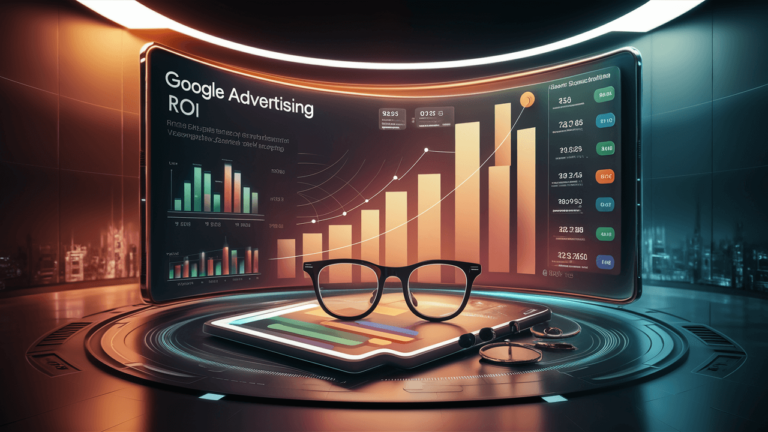Mastering Google Advertising ROI for Business Growth
Google Advertising stands as a cornerstone of the digital marketing world. With millions of businesses vying for visibility, Google’s vast network offers a unique platform where ads can reach billions of users across the globe. Through search engine results, YouTube videos, and partner websites, Google Ads provides unparalleled access to potential customers.
However, simply investing in advertising isn’t enough. Businesses must understand and maximize their Return on Investment (ROI). ROI in advertising measures how effectively your advertising spend translates into profit. It’s calculated by comparing the revenue generated from ads to the cost of those ads. For example, if you spend $100 on Google Ads and generate $300 in sales directly from those ads, your ROI is 200%. This metric is critical because it directly reflects the effectiveness and efficiency of your advertising efforts, guiding better budgeting and strategy decisions.
As digital landscapes evolve and competition stiffens, mastering Google Advertising ROI isn’t just beneficial; it’s essential for ensuring sustainable growth and competitive advantage in today’s market.
Understanding Google Advertising ROI
Google Advertising ROI is a crucial metric that measures the efficiency of your advertising spend in generating profits. At its core, ROI involves two fundamental components: Cost and Revenue generated from ads. The Cost refers to the total expenditure on your Google Ads campaigns, including bids, ad creation, and management fees. The Revenue generated from ads is the income derived from customers who have clicked on those ads and completed a purchase or a desired action.
Calculating ROI in Google Ads requires a simple formula:

For instance, if you spend $1,000 on your Google Ads and they result in sales worth $4,000, your ROI would be:

This indicates that for every dollar spent, you’re earning three dollars back.
The importance of setting clear, measurable objectives cannot be overstated. These objectives guide your advertising strategy and provide a benchmark against which to measure success. For example, if your goal is to increase online sales by 20% within three months, you would set up your Google Ads campaigns to specifically target potential customers who are likely to purchase. By monitoring your ROI relative to this objective, you can adjust your strategies to ensure they are aligned with your business goals, maximizing both effectiveness and profitability.
Understanding and optimizing your Google Advertising ROI isn’t just about seeing a return; it’s about refining your investments to continually yield better results and achieve specific business outcomes.
Key Metrics That Influence Google Advertising ROI
When managing Google Ads, understanding key performance indicators (KPIs) is essential for assessing the success of your campaigns and ultimately influencing your ROI. The four primary KPIs to focus on are Click-Through Rate (CTR), Cost per Click (CPC), Conversion Rate, and Cost per Acquisition (CPA).
Click-Through Rate (CTR) measures the percentage of people who click on your ad after seeing it. A high CTR indicates that your ad is relevant and engaging to your target audience. For example, a CTR of 5% means that out of 100 ad impressions, your ad was clicked 5 times. Higher CTRs can lead to better ad placement and potentially lower costs.
Cost per Click (CPC) is the amount you pay each time someone clicks on your ad. This metric helps you understand the cost-effectiveness of your campaign. Managing CPC effectively ensures you are not overspending for the traffic you receive. For instance, if your average CPC is $2, but each visitor typically purchases $50 worth of products, your spending is likely justified.
Conversion Rate is a measure of how many clicks on your ad result in a conversion, such as a sale, sign-up, or other desired action. This KPI is vital for evaluating the effectiveness of your ad in driving the desired actions. A conversion rate of 10% means that 10% of the clicks on your ad lead to conversions, demonstrating the effectiveness of your ad content and targeting.
Cost per Acquisition (CPA) reflects the average cost of acquiring a customer who completes a transaction or a specified action. This metric is crucial for determining the actual cost to your business of gaining a new customer. For example, if your CPA is $30, and the average customer spends $100, your investment in acquiring new customers is profitable.
These metrics directly influence ROI calculations by affecting both the cost and revenue aspects of your campaigns. Effective management of these KPIs can lead to improved ROI by ensuring that your advertising spend translates into significant business results. By continuously monitoring and optimizing these metrics, advertisers can make informed decisions to adjust campaigns, reduce costs, and enhance overall profitability.
Strategies to Maximize Google Advertising ROI
Maximizing your Google Advertising ROI involves several strategic approaches designed to enhance both the effectiveness and efficiency of your campaigns. Optimizing ad campaigns for better targeting, using ad extensions, and refining keyword strategies are foundational techniques to improve your return on investment.
Optimizing Ad Campaigns for Better Targeting: Effective targeting is crucial in ensuring that your ads reach the most relevant audience. Tailoring your ads based on user demographics, interests, and behaviors increases the likelihood of attracting clicks from potential customers who are more likely to convert. For instance, if you’re selling fitness equipment, you might target users interested in health and wellness websites.
Using Ad Extensions: Ad extensions enhance your ads by providing additional information and ways to interact with your ad, such as phone numbers, site links, or additional product information. These extensions improve the visibility and attractiveness of your ads, leading to higher CTRs and potentially better conversion rates. For example, a site link extension could direct users not just to your homepage but directly to a product page or a contact form.
Refining Keyword Strategies: Keywords are the foundation of any Google Ad campaign. Selecting the right keywords means balancing relevance, competition, and search volume. Long-tail keywords, while attracting less traffic, can lead to higher conversion rates as they target more specific user intents. Regularly reviewing and refining your keyword list helps to avoid wasted spend on non-performing keywords and to capitalize on emerging trends.
Role of A/B Testing: A/B testing is a powerful method for maximizing ROI by comparing different versions of your ads to see which performs better. This can involve testing variations in wording, layout, or imagery in the ads. By systematically testing these elements, you can continuously improve the effectiveness of your campaigns. For instance, testing two different call-to-action phrases might reveal that one significantly outperforms the other in driving conversions.
Implementing these strategies not only helps in fine-tuning your campaigns but also in driving substantial improvements in ROI. Continuous testing, learning, and adjusting are key to staying competitive in the ever-evolving landscape of Google Advertising.
Tools and Technologies to Track Google Advertising ROI
To effectively measure and optimize Google Advertising ROI, leveraging the right tools and technologies is essential. Google Analytics and Google Ads reporting features are integral in tracking campaign performance and ROI. Furthermore, integrating these tools with other data platforms can provide a more comprehensive view of advertising performance.

Google Analytics is a powerful tool for tracking not just basic traffic metrics but also detailed conversion tracking. It provides insights into how users interact with your website after clicking on your ads, including which pages they visit, the duration of their visits, and the actions they take. This data is crucial for calculating ROI by correlating specific user behaviors and conversions directly to your Google Ads campaigns. For instance, you can set up goals in Google Analytics to track specific conversions like newsletter signups or product purchases directly attributed to your ads.
Google Ads’ reporting features offer a direct look at the campaign performance, including data on impressions, clicks, CTR, and CPC. These features allow advertisers to see real-time data and make immediate adjustments to enhance campaign performance. Advanced features like conversion tracking and revenue reporting help in directly calculating ROI by showing exactly how much revenue each ad and campaign is generating compared to the spend.
Integrating these tools with other data platforms enhances your ability to analyze ROI across different channels. For example, integrating Google Analytics with a CRM system can help track the customer journey from initial ad exposure through to post-sale behaviors, providing a deeper understanding of how Google Ads contribute to overall business goals. Additionally, using data visualization tools like Tableau or Microsoft Power BI can help amalgamate data from multiple sources, offering visual insights into performance trends and ROI across all marketing efforts.
By effectively using these tools, marketers can not only track and improve their Google Advertising ROI but also gain valuable insights into the broader impact of their marketing strategies, allowing for data-driven decisions that propel business growth.
Case Studies and Real-World Examples
Exploring real-world examples provides valuable insights into successful strategies and practical applications of Google Advertising campaigns. Below, we delve into several case studies where businesses achieved high ROI through their Google Ads efforts, highlighting what they did well and how these strategies can be applied by other businesses.
Case Study 1: Local Retail Store Expansion
A local retail store specializing in outdoor sports equipment decided to use Google Ads to increase store visits and online sales. By targeting ads based on local search terms and using location extensions, the store saw a 50% increase in foot traffic and a 120% rise in online sales over six months. The key to their success was using geo-targeted ads that reached potential customers who were near the store and likely interested in outdoor activities.
Key Takeaway: Geo-targeting and location extensions can significantly enhance visibility and drive both online and physical store traffic, particularly for local businesses.
Case Study 2: E-commerce Platform’s Seasonal Promotion
An e-commerce platform launched a Google Ads campaign for a seasonal promotion focusing on back-to-school products. They utilized a combination of search ads targeted at high-intent keywords and remarketing ads to reach users who had previously visited their site but did not make a purchase. The campaign resulted in a 200% ROI with a 30% increase in conversion rate compared to the previous period.
Key Takeaway: Tailoring your ads to seasonal events and reinforcing them with remarketing strategies can capture high-intent customers and encourage repeat visits, increasing conversion rates and ROI.
Case Study 3: Tech Startup’s Innovative Use of Video Ads
A tech startup used Google Video Ads to introduce a new product. They created engaging, informative videos that highlighted the unique features of their product. By targeting tech enthusiasts on YouTube and incorporating calls-to-action that directed viewers to a landing page, they achieved an ROI of 300%. The videos helped not only in driving direct sales but also in building brand awareness.
Key Takeaway: Video ads are an effective medium for demonstrating product features and can lead to high engagement rates, especially when combined with targeted advertising to appropriate audiences.
These case studies illustrate the versatility and effectiveness of Google Ads across different industries and objectives. By understanding the specific strategies that contributed to these successes, other businesses can adopt similar approaches tailored to their unique products, markets, and goals. Emphasizing the importance of targeted advertising, engaging content, and strategic use of ad extensions and formats can help replicate these successes in other contexts.
Common Pitfalls and How to Avoid Them
Navigating Google Ads can be complex, and even seasoned marketers can fall into traps that diminish the effectiveness of their campaigns. Understanding common mistakes and learning how to avoid them can significantly enhance your Google Advertising ROI. Here are several pitfalls to watch out for, along with strategies to circumvent them.
Pitfall 1: Poor Keyword Selection
Choosing the wrong keywords is one of the most common mistakes that can lead to wasteful spending and low campaign effectiveness. For instance, overly broad keywords might generate a lot of traffic but low conversion rates, while overly niche keywords might not generate enough traffic.
How to Avoid: Conduct thorough keyword research to identify terms that your target audience is using. Utilize tools like Google Keyword Planner to find the right balance between search volume and competition. Regularly refine and optimize your keyword list based on performance data.
Pitfall 2: Ignoring Negative Keywords
Not using negative keywords can result in ads appearing for irrelevant searches, wasting your budget on clicks that are unlikely to convert.
How to Avoid: Regularly update your negative keyword list to exclude terms that are unrelated to your business. This will help focus your ad spend on searches with a higher likelihood of conversion, improving your overall ROI.
Pitfall 3: Failing to Optimize Ad Copy
Uncompelling or irrelevant ad copy can result in low CTR and poor conversion rates, even if your keywords and targeting are spot-on.
How to Avoid: Write clear, engaging ad copy that directly addresses the needs and interests of your target audience. Include strong calls-to-action (CTAs) that encourage users to click through. Test multiple variations of your ad copy using A/B testing to determine which messages resonate best with your audience.
Pitfall 4: Neglecting Mobile Optimization
With the increasing use of mobile devices for internet browsing and shopping, not optimizing ads for mobile users can result in a significant loss of potential conversions.
How to Avoid: Ensure that your ads and landing pages are optimized for mobile devices. Use mobile-preferred ads in your campaigns and check that your website provides a seamless mobile experience.
Pitfall 5: Overlooking Conversion Tracking
Without proper conversion tracking, you can’t accurately measure ROI or identify which aspects of your campaigns are working.
How to Avoid: Set up conversion tracking in Google Ads and Google Analytics to monitor the actions users take after clicking your ads. This data is crucial for optimizing campaigns and allocating your budget effectively.
By recognizing these common pitfalls and implementing the strategies to avoid them, businesses can improve the efficiency of their Google Ads campaigns and enhance their advertising ROI. Continuous monitoring and adjustment based on detailed performance analysis are key to maintaining effective and profitable advertising strategies.
Conclusion
Throughout this article, we have explored the multifaceted approach required to maximize Google Advertising ROI. Starting with a foundational understanding of what ROI entails and the critical metrics involved, such as Click-Through Rate (CTR), Cost per Click (CPC), Conversion Rate, and Cost per Acquisition (CPA), we’ve emphasized the importance of these indicators in shaping effective advertising strategies.
We delved into actionable strategies to enhance ROI, including optimizing ad campaigns for better targeting, the innovative use of ad extensions, refining keyword strategies, and the crucial role of A/B testing in fine-tuning ad effectiveness. Additionally, we reviewed essential tools like Google Analytics and Google Ads reporting features that aid in tracking and analyzing campaign performance, and how their integration with other data platforms can offer a comprehensive view of advertising results.
Real-world examples in the form of case studies illustrated how varied businesses achieved remarkable ROI improvements by applying tailored Google Ads strategies. However, awareness of common pitfalls and knowledge on how to avoid them, such as poor keyword selection, ignoring negative keywords, and neglecting mobile optimization, are equally important to ensure sustained success.
To ensure continuous improvement and optimal performance of your Google Ads campaigns, it is crucial for businesses to regularly assess and refine their strategies. Stay updated with the latest Google Ads features and industry trends, and always test new approaches to discover what works best for your specific market and objectives.
By committing to a cycle of ongoing evaluation and adjustment, businesses can not only sustain but also enhance their advertising ROI, leading to better profitability and business growth. Embrace these practices, and watch your Google Advertising efforts turn into rewarding investments.





